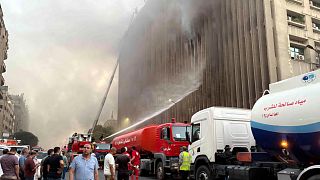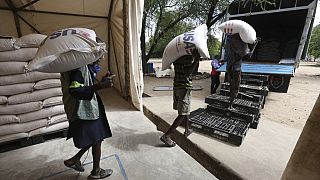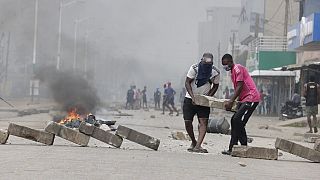Egypt
As rises in temperatures affect different aspects of people's lives, in Egypt, climate change is affecting the Nile River, a water supply source that 10 countries rely on for their crops and power. As a result some Egyptian farmers have turned to solar power.
In Egypt's delta, solar panels financed by the UN are helping farmers power the irrigation of their crops. Soaring fuel costs are encouraging some farmers to turn to renewable energy like solar power but even that is sometimes financially out of reach.
"Many places here are out of the reach of the electricity grid, so farmers depend on diesel fuel which is really hard [to get], as it costs a lot of money. We are talking about a huge amount of fuel, not just a few liters, as the land needs huge amount of water especially in summer, which in turn requires a lot of fuel. Additionally, (the machine) needs new oil every 100 operating hours, not to mention maintenance fees. This is why farmers are turning to solar energy, in order to reduce the total cost,” explains Jomaa Ibrahim, solar power operator.
"Many farmers want to install solar panels, but due to the high cost, they can’t,” he adds.
Solar energy is one of the most successful and effective solutions to reduce fuel consumption, which causes increased CO2 emissions.
"We have 192 panels for four solar stations, 48 panels for each. The 192 panels are used to irrigate 243 acres of land” describes Amr al-Daqaq, chief of irrigation sector in Kaf el-Dawar .
Under Egypt’s 2030 Vision, the government intends to increase the supply of electricity generated from renewable sources to 42% by 2035.
This vision is set to help Egypt apprehend it numerous climate change issues, notably the steadfast disappearance of the Nile.
Disappearance of the Nile
Climate change, pollution and human exploitation are putting existential pressure on the world's second longest river, on which half a billion people depend for survival.
Today, the Nile is no longer the unperturbable river of myth.
All along its 6,500-kilometre (4,000-mile) length, alarm bells are ringing as the river slowly dries up.
"The Nile is the most important thing for us," said Jomaa, who at 17 is the latest generation of his family to work the river's rich banks at Alty in Gezira state.
"We certainly do not wish for anything to change," he said.
In half a century, its flow has dropped from 3,000 cubic metres (10,600 cubic feet) per second to 2,830 cubic metres.
Yet it could get much, much worse. With multiple droughts in east Africa, its flow could fall by 70 percent, according to the United Nations' most dire predictions.
Every year for the past six decades, the Mediterranean has eaten away between 35 and 75 metres (38-82 yards) of the Nile Delta. If the sea level rises even by a metre, a third of this intensely fertile region could disappear, the UN fears, forcing nine million people from their homes.
What was once a breadbasket has become the third most vulnerable place on the planet to climate change.
Lake Victoria, the Nile's biggest source of water after rainfall, could also dry up due to drought, evaporation and slow tilts in the Earth's axis.
All but three percent of Egypt's 104 million people live along the river on just eight percent of the country's territory. It is a similar story in neighbouring Sudan, with half its 45 million people living along its banks, and the Nile supplying two-thirds of its water.
By 2050, the population of both countries will have doubled, and it will be two or three degrees hotter.
The UN's group of climate experts, the IPCC, say the impact on the Nile will be catastrophic. They predict it will lose 70 percent of its flow by the end of the century, with the water supply available to every person along it plummeting to a third of what they have now.
Floods and other violent storms likely to lash East Africa as the climate warms will only make up 15 to 25 percent of that lost water, the IPCC has warned.
With such grim scenarios in store, governments have scrambled to capture its flow.
The COP27 which is due to open on November 6 in the country, should be the occasion to discuss viable timeless solutions with other World leaders.













02:20
France: Avignon Festival celebrates Egyptian diva Umm Kulthum
02:30
Morocco’s oases struggle to survive amid growing desertification
01:42
Gaza conflict overshadows EU-Southern Neighbourhood talks in Brussels
01:05
Ethiopia's mega-dam on the Nile is "now complete", Prime Minister says
01:52
In Goma, solar power brings light and hope in Ndosho neighbourhood
01:15
Morocco says 2024 was the hottest year with temperatures reaching 47.7 degrees